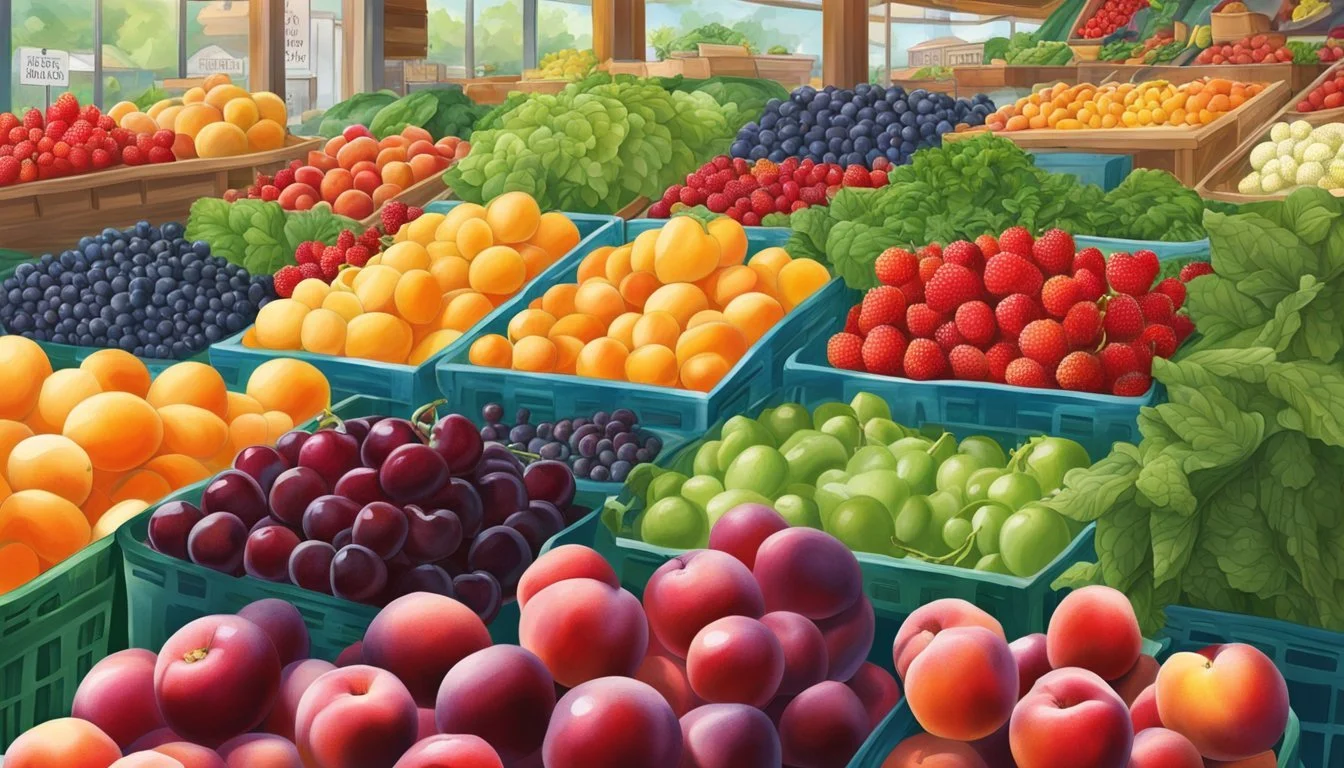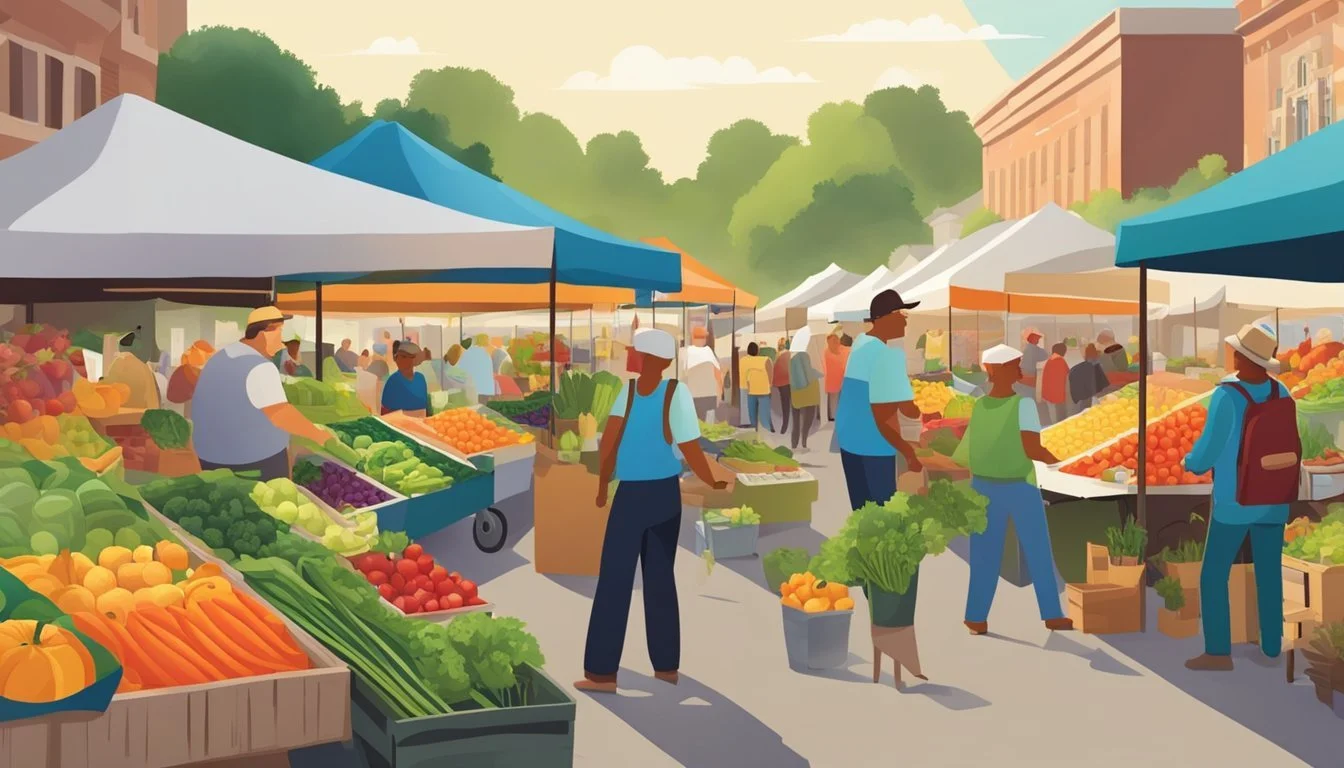New Hampshire Seasonal Fruit & Vegetables in July
Your Fresh Guide
This Article is Part of our New Hampshire Seasonal Fruit & Veg Calendar
In New Hampshire, the month of July marks a bountiful period for local produce. As summer reaches its zenith, the state's farms and orchards become hubs of activity. The harvest of July in New Hampshire presents a diverse range of fruits and vegetables that flourish under the nurturing northeastern sun. Local markets brim with the vibrant colors and fresh flavors of the season, as consumers seek out the freshest picks from nearby fields.
Seasonal fruits such as blueberries and raspberries reach their peak, providing sweet and tangy treats perfect for summer desserts or fresh snacking. The fields also offer early varieties of apples and peaches, which are just beginning to ripen and suggest the promise of a full harvest to come. Vegetables, too, share in the July abundance with offerings like summer squash, cucumbers (how long do cucumbers last?) , and green beans.
This period in the New Hampshire harvest calendar is integral to both the local economy and the culinary scene, as it delivers the freshest, most nutritious produce to the community. Local chefs and home cooks alike relish in the opportunity to create dishes that showcase the freshness that only seasonal July fruits and vegetables can bring. With a shift towards locally sourced and seasonal eating, New Hampshire's July harvest plays a crucial role in maintaining the state's commitment to agricultural sustainability and community health.
Understanding New Hampshire's Growing Season
New Hampshire's growing season is characterized by its varied climate, which shapes the timeline and peak of the summer harvest. Knowing the particularities of this region's agriculture helps consumers appreciate the optimal time for the freshest produce.
Climate Influences
New Hampshire experiences a climate that significantly affects its agriculture. The state has cold, snowy winters and warm, humid summers, with a shorter growing season than many other regions due to its northern location. July's warm temperatures and long days present optimal conditions for a variety of produce, but also require monitoring for potential droughts or excessive rainfall.
Seasonal Timeline
The state's growing season mainly stretches from late spring through early fall, with June marking the beginning of the harvest for early summer crops. By July, the season has reached its peak, offering the widest variety of fresh produce. As summer progresses into August, some crops begin to wind down while others remain robust.
Summer Harvest Peak
During the month of July, New Hampshire's harvest is abundant. A variety of fruits and vegetables are at their prime, making it an ideal time for local markets and farm stands. Noteworthy summer produce includes:
Fruits: Blueberries, cherries (how long do cherries last?), peaches, and raspberries.
Vegetables:
Leafy greens such as lettuce and spinach
Root vegetables like carrots and beets (how long do beets last?)
Summer squash and zucchini reaching peak availability
Farmers closely monitor these crops during the summer to ensure optimal harvest conditions, leading to the freshest and most flavorful produce for consumers.
Seasonal Fruits Available in July
July in New Hampshire is a peak time for a diverse array of fruits. This month offers the best of summer's bounty with a wealth of options ranging from sweet berries to juicy stone fruits.
Berry Varieties
Berries thrive in July's warm weather, presenting a selection that is both rich in flavor and high in nutritional value.
Blueberries: These indigo berries are at their plump and sweetest best.
Raspberries: Available in red and black varieties, raspberries are perfect for fresh eating or preserves.
Strawberries: While the strawberry season is winding down, there may still be some late harvests to enjoy.
Stone Fruits
Stone fruits, named for their hard pit, come into full swing in July, offering a juicy and flavorful treat.
Peaches: Freestone peaches are typically ready to be picked, characterized by their ease of separating flesh from stone.
Nectarines: Smooth-skinned relatives of peaches, these are ripe for the picking and packed with sunny flavor.
Plums: A variety of plums become available, ranging from sweet to tart, providing ample choice for fresh eating or culinary use.
Cherries: Sweet cherries are in their last weeks, while sour varieties, ideal for baking, are just starting.
Summer Specials
In addition to berries and stone fruits, July also yields special fruit harvests emblematic of summer's sweetness.
Melons: Look for cantaloupes (how long does cantaloupe last?) and watermelons beginning to surface in the market, signaling the height of summer.
Seasonal Vegetables Available in July
July in New Hampshire offers a rich tapestry of vegetables reaching their peak; residents are privy to an abundance of fresh produce.
Leafy Greens and Herbs
In July, gardens and markets are flush with a variety of leafy greens. One will find robust kale and tender spinach leaves perfect for salads and smoothies. Lettuce thrives in the summer warmth, presenting numerous varieties from crisp romaine to delicate butterhead. Thriving alongside these leafy staples are herbs such as fragrant basil and robust oregano, essential for elevating any culinary creation.
Root Vegetables
The earthy bounty of root vegetables is prominent in July with beets, carrots, and radishes adding color and nutrition to meals. Beets are versatile, good for roasting or adding to salads. Carrots, enjoyed for their sweetness, come in shades from traditional orange to purples and yellows. Radishes, with their peppery kick, are perfect for giving dishes a crisp bite.
Summer Staples
The true stars of the summer garden are the vegetables that define the season. Varieties of cucumbers and zucchini are abundant, ideal for refreshing salads or sautés. Tomatoes begin to hit their stride, ready for sandwiches, sauces, or enjoying fresh off the vine. Both corn (how long does corn last?) and beans make their appearance, with corn's sweetness and beans' crisp texture being favored in side dishes. Peppers also come into season, ranging from sweet bell to fiery chillies, ready to add zest to any dish.
Local Farming Practices
New Hampshire farmers employ various methods to sustain agriculture and ensure the production of high-quality fruits and vegetables in July. They focus on sustainable practices and organic farming to enhance local food systems and reduce environmental impact.
Sustainable Agriculture
Sustainable agriculture in New Hampshire revolves around maintaining economic viability while protecting the environment. Local farmers incorporate crop rotation to maintain soil health and prevent disease. They employ integrated pest management (IPM) strategies, which use a combination of biological, cultural, physical, and chemical tools to manage pests with minimal environmental disturbance. In the face of unpredictable weather, greenhouses help to extend the growing season and protect sensitive crops from harsh conditions.
Key Sustainable Practices
Crop Rotation: Enhances soil nutrients and breaks pest and disease cycles.
Integrated Pest Management: Combines multiple approaches for effective pest control.
Greenhouses: Provide a controlled environment for year-round production.
Organic Farming
Organic farming is a significant part of New Hampshire's agricultural scene. Many local farms have obtained organic certification to guarantee that their produce meets stringent standards. They focus on natural methods to enrich the soil, such as composting and the use of green manures. Organic farmers strictly avoid synthetic pesticides and fertilizers, incorporating natural predators to tackle pest problems and fostering biodiversity to boost disease resistance.
Organic Farming Highlights
Certified Organic: A label ensuring produce meets strict organic standards.
Natural Soil Enrichment: Utilizing compost and green manures to nourish the soil.
Pest Control: Introducing beneficial insects to naturally manage pest populations.
Disease Management: Encouraging a diverse ecosystem to naturally reduce plant diseases.
Preparing and Storing Seasonal Produce
In handling and preserving July's seasonal produce in New Hampshire, ensuring freshness, nutritional value, and flavor retention is vital. Produce should be consumed when ripe for optimum health benefits.
Handling Fresh Produce
It is crucial for individuals to be gentle with seasonal fruits and vegetables, as they are often at their most tender and ripe. Harvested produce should be washed thoroughly under running water to remove any surface dirt and reduce the presence of contaminants. Raw fruits and vegetables can also be dried with a clean cloth or paper towel to minimize moisture, which discourages bacterial growth. When storing fresh produce, they should be kept at the correct temperature to maintain freshness and flavor. For example, tomatoes should be stored at room temperature, while leafy greens are best kept in the refrigerator’s crisper drawer.
Tomatoes: Room temperature, away from direct sunlight
Leafy Greens: Refrigerator, high humidity compartment
Berries: Refrigerator, in a container lined with paper towels
Stone Fruits: Refrigerate once ripe
Preservation Techniques
There are several preservation methods to extend the life of seasonal produce. Freezing is an excellent way to preserve the nutritious quality of fruits and vegetables, while also locking in their natural flavors. For optimal results, one should blanch vegetables prior to freezing, which helps retain color and texture. Canning fruits and vegetables is another popular method, allowing them to be stored and enjoyed for months. With drying, moisture is removed, concentrating both the flavor and nutrients, making for a longer shelf life and easy storage.
Freezing: Blanch vegetables, then freeze; freeze fruits on a tray before transferring to airtight containers.
Canning: Use approved recipes and techniques to ensure safety; acidify tomatoes.
Drying: Dehydrate fruits or vegetables until pliable but not moist; store in a cool, dry place.
Community and Economic Impact
July in New Hampshire shines a spotlight on the integral role that local produce plays in supporting community well-being and bolstering the state's economy. Farmers' markets serve as vital hubs for both commerce and social interaction, while the local economy benefits from the circulation of dollars within the state.
Farmers' Markets
Farmers' markets in New Hampshire are more than just venues to procure fresh fruits and vegetables; they are communal spaces that foster direct interactions between consumers and growers. During the month of July, these markets are teeming with locally grown produce, ensuring that the revenue generated stays within the community. The presence of farmers' markets also helps to reduce food insecurity by expanding access to nutritious foods, which is particularly noteworthy given that approximately 7% of New Hampshire residents experience food insecurity.
Local Economy
The economic impact of the harvest season in New Hampshire extends beyond the transactions at farmers' markets. By focusing on the purchase of local produce, consumers aid in sustaining the agricultural sector and contribute to creating jobs within the community. The infusion of capital into the local economy reverberates through various sectors, from transportation to retail. The United States, and New Hampshire in particular, benefits from a strengthened agricultural economy as it promotes food self-sufficiency and reduces dependency on imported goods.
Cooking and Recipes
In July, New Hampshire's local produce brings a vibrant palette of flavors to the kitchen. This month, the focus is on incorporating fresh, nutritious ingredients into cooking to take advantage of the summer's bounty.
Seasonal Recipes
For the adventurous home cook, seasonal recipes offer a way to showcase fresh produce. Here's a selection of dishes that highlight July's harvest:
Chilled Cucumber Soup: Utilize crisp cucumbers and fresh dill (how long does dill last?) for a refreshing starter.
Grilled Corn and Tomato Salad: A combination of sweet corn and juicy tomatoes, topped with a basil vinaigrette, makes a perfect side dish.
Sautéed Green Beans with Garlic: Quick and easy, this side dish accentuates the bean's natural flavor.
Berry and Peach Crisp: End your meal with a dessert that features ripe berries and peaches beneath a crumbly oat topping.
Cooking Tips
Here are some tips to enhance the cooking experience with July's seasonal offerings:
Flavor Pairings: Pair the sweetness of corn with spicy peppers, or contrast the tartness of raspberries with rich dark chocolate.
Grilling Vegetables: Grill zucchini, eggplant, and peppers to caramelize their natural sugars and develop a deeper flavor.
Herb Infusions: Enhance dressings and marinades with fresh herbs like basil, parsley, and cilantro to elevate simple dishes.
Storing Produce: Keep berries dry and refrigerate them in a single layer to prolong freshness, and store root vegetables like beets in a cool, dark place.








